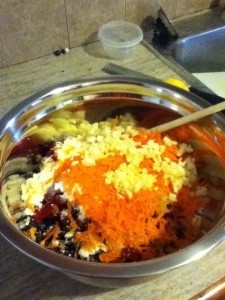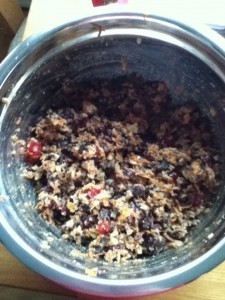The adventure of the Christmas pudding – Part 1. Preparation
We celebrate Christmas with our Bothwell cousins and we’re traditionalists. Especially cousin Bob who believes an old-fashioned steamed pudding is the only way to end a proper Christmas dinner. So it’s been my pleasure for the past six years to bring the pudding. Over the years I’ve found the recipe and method that works best for me.
A Christmas pudding isn’t difficult to make, but it does include rather a lot of ingredients and requires some special equipment.

Most of the ingredients are in. Now comes the fun part. Stirring!
In Britain, the last Sunday of November is called Stir Up Sunday as that’s the day the pudding is traditionally made. I set aside the last weekend in November for the project. Saturday is for making the batter and Sunday is for steaming. The pudding can and should be made well in advance of the big day.
I start gathering the ingredients a week or so before. Some of them I get at the Bulk Barn and I’ve devised a clever way to do that. I bring a two-cup measuring jug, line it with a plastic bag for each ingredient I wish to purchase, and then measure the exact amount. When it comes time to assemble the ingredients, I have exactly the amount I need, already measured, with no waste or leftovers.
The recipe I use is from English Traditional Recipes: A Heritage of Food and Cooking by Annette Yates.
Christmas Pudding
5 cups fresh breadcrumbs
1 cup brown sugar
1 cup currants
2 cups raisins
1 1/3 cups golden raisins
1/3 cup candied peel, chopped
½ cup glace cherries
8 oz. suet
½ tsp salt
2-4 tsp mixed spice (2 tsp cinnamon, 1 tsp nutmeg, ½ tsp allspice, dash ground cloves)
1 carrot, peeled and grated
1 apple, finely chopped
grated rind and juice of 1 orange
2 large eggs, lightly whisked
2 cups stout
Method
Put breadcrumbs, sugar, dried fruit and peel in large mixing bowl. Add suet, salt, mixed spice, carrot, apple and orange rind. Mix well.
Stir the orange juice, eggs and stout into breadcrumb mixture. Leave overnight, stirring if possible.
Note: The recipe calls for suet, which can be difficult to find. In Britain, you can get a vegetarian equivalent but I have not seen that here. However, you must use suet as it highs a high melting temperature. Don’t be tempted to substitute something else, like shortening, or you’ll end up with a gloppy, greasy mess.
And don’t make the mistake I did one year and use dried bread crumbs. They’ll soak up too much of the liquid.
This year, I substituted dry cranberries for the golden yellow raisins. We’ll see how that works out!
Tip: Photocopy recipe and cross off the ingredients as you add them to make sure you don’t leave anything out!

The batter will rest overnight, ready for steaming in the morning.
In part 2 we’ll look at the steaming process.
Elizabeth J. Duncan's Blog
- Elizabeth J. Duncan's profile
- 399 followers



